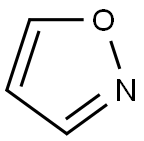Isoxazole derivatives as anticancer agents
Mar 4,2024
General Description
Various isoxazole derivatives have shown significant potential as anticancer agents in recent studies. 3,4-isoxazole compounds have demonstrated promising anticancer activity, with favorable in vitro and in vivo efficacy against solid and hematological tumors. Additionally, KRIBB3 (compound 31) exhibited potent antitumoral effects against various cancer types by inhibiting tumor cell migration and impacting tubulin polymerization. Furthermore, 3,5-isoxazole derivatives and other isoxazole compounds have displayed cytotoxicity against different cancer cell lines, showcasing their diverse anticancer properties and potential as therapeutic agents for various malignancies.

Figure 1. Isoxazole
3,4,5-Isoxazole compounds as anticancer agents
3,4,5-Isoxazole have emerged as promising anticancer agents due to their ability to inhibit the HSP90 protein, which stabilizes various proteins involved in oncogenesis. Researchers have developed several isoxazole-based HSP90 inhibitors, including NVP-AUY922 and its derivatives. Compounds with diversified amino acid derivatives to the 3-amido motif of the isoxazole scaffold have shown high binding potency against HSP90 and inhibited human lung and breast cancer cells. Another series of isoxazole derivatives linked by alkynes have displayed improved anti-proliferative activity towards several human cancer cell lines. Fragment screening with X-ray crystallography techniques has led to the development of a series of HSP90 inhibitors, with compound 7 showing strong inhibition of HSP90 and significant tumor growth inhibition in vivo. A novel 3,4-diarylpyrazole resorcinol HSP90 inhibitor and its corresponding isoxazole have also been compared, with isoxazole displaying greater antiproliferative potency and improved cellular uptake. Scopoletin-isoxazole hybrids have exhibited better cytotoxic activities against human cancer cell lines, with compound 11 displaying significant anti-proliferative activity similar to sunitinib. Isoxazoles have also been explored as BET bromodomain inhibitors, with newly developed isoxazole PNZ5 showing potent inhibition and high selectivity of gastric cancer cell growth. Finally, modifications of the natural product Combretastatin A-4 have produced a series of newly designed and synthesized compounds, with XN05 showing better antiproliferative activity against human hepatocellular carcinoma cells. 1
3,5-Isoxazole compounds as anticancer agents
3,5-Isoxazole compounds have shown promising anti-cancer properties in recent studies. Hanumappa Ananda synthesized 3,5-disubstituted isoxazole derivatives and tested their antiproliferative properties against cancer cell lines MCF7 and HeLa. Compound 15 displayed significant inhibition of proliferation of these cells, indicating that it can be used to further derivatize novel chemical entities for the treatment of breast cancer. Similarly, a series of 5-(3-alkylquinolin-2-yl)-3-aryl isoxazole derivatives were synthesized and evaluated for their cytotoxicity against four human cancer cell lines. Compound 16 showed potent cytotoxicity against all the tested cell lines. The introduction of isoxazole ring to different structures, such as chromene-based structure and curcumin, resulted in compounds 20 and 22, respectively, which displayed potent cytotoxic activity against human tumor cell lines. Additionally, isoxazole compound 23 was found to play an important role in pancreatic cancer cell migration and invasion, making it a potential therapeutic target for pancreatic cancer. Novel indole-containing isoxazole derivatives, such as compound 24, showed sPLA2 inhibitory activity and in vitro antiproliferative activity against breast and prostate cancer cells. Isoxazole compound 27 was identified as a broad-spectrum MMP inhibitor, while compound 29 was found to be a selective and potent RET inhibitor, inducing apoptosis and growth inhibition in TT cell lines. These findings highlight the potential of isoxazole compounds as anticancer agents. 2
3,4-Isoxazole compounds as anticancer agents
3,4-Isoxazole compounds have shown promising potential as anticancer agents in recent studies. Baruchello et al focused on modifying the C-4 position of the isoxazole scaffold of NVP-AUY922 and discovered a series of 3,4-isoxazolediamide compounds with low nanomolar range IC50 values. Compound 30 exhibited interesting activity both in vitro and in vivo, prompting further assessment in various solid and hematological tumors. The preclinical data demonstrated its favorable activity profile, tolerability, and manageability, positioning compound 30 as a highly attractive antitumor therapeutic agent ready for clinical studies. In another study, Shin et al identified KRIBB3 (compound 31) through chemical screening aimed at finding inhibitors of tumor cell migration. Surprisingly, KRIBB3 not only inhibited tumor cell migration but also demonstrated significant antitumoral activity against various malignancies, including colon, prostate, breast, and lung cancers. When administered intraperitoneally to mice, KRIBB3 resulted in a substantial reduction in tumor volume. Mechanistic studies revealed that KRIBB3 inhibits tubulin polymerization and activates the mitotic spindle checkpoint, contributing to its antiproliferative effects. The unique structural and biological properties of KRIBB3 make it a promising drug candidate for further development and potential clinical applications. 3
Reference
1. Zhu J, Mo J, Lin HZ, Chen Y, Sun HP. The recent progress of isoxazole in medicinal chemistry. Bioorg Med Chem. 2018;26(12):3065-3075.
2. Ananda H, Kumar KSS, Hegde M, Rangappa KS. Induction of apoptosis and downregulation of ERα in DMBA-induced mammary gland tumors in Sprague-Dawley rats by synthetic 3,5-disubstituted isoxazole derivatives. Mol Cell Biochem. 2016;420:141-150.
3. Shin KD, Yoon YJ, Kang YR, et al. KRIBB3, a novel microtubule inhibitor, induces mitotic arrest and apoptosis in human cancer cells. Biochem Pharmacol. 2008;75:383-394.
- Related articles
- Related Qustion
- Isoxazole Apr 11, 2023
?Isoxazoles belong to an important class of five-membered aromatic heterocycles containing two electronegative heteroatoms, nitrogen and oxygen, in a 1,2-relationship and three regular sp2 carbon atoms.
Preclinical studies support perampanel as an effective antiepileptic drug, selectivity for AMPA receptors. Clinical trials confirm its efficacy in managing focal and tonic-clonic seizures.....
Mar 4,2024APIAntioxidant 1330 is a versatile phenolic primary antioxidant used for thermal stabilization, with potential as an effective catalyst in silyl ketene acetal synthesis.....
Mar 4,2024API




